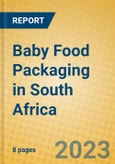Flexible plastic and folding cartons remained popular packaging types for dried baby food in South Africa (the second largest category in baby food packaging), as they are considered more lightweight and easy to transport, making them convenient for parents on the go. These pack types also offer excellent barrier properties, ensuring that the dried baby food remains fresh and free from moisture, light, and air, which can degrade the quality and nutritional value of the product.
The Baby Food Packaging in South Africa report offers insight into key trends and developments driving packaging across the category. The report also examines trends and prospect for various pack types and closures: metal packaging, rigid plastic, glass, liquid cartons, paper-based containers; flexible packaging.
Product coverage: Dried Baby Food, Milk Formula, Other Baby Food, Prepared Baby Food.
Data coverage: Market sizes (historic and forecasts), company shares, brand shares and distribution data.
The Baby Food Packaging in South Africa report offers insight into key trends and developments driving packaging across the category. The report also examines trends and prospect for various pack types and closures: metal packaging, rigid plastic, glass, liquid cartons, paper-based containers; flexible packaging.
Product coverage: Dried Baby Food, Milk Formula, Other Baby Food, Prepared Baby Food.
Data coverage: Market sizes (historic and forecasts), company shares, brand shares and distribution data.
Why buy this report?
- Get a detailed picture of the Baby Food Packaging market;
- Pinpoint growth sectors and identify factors driving change;
- Understand the competitive environment, the market’s major players and leading brands;
- Use five-year forecasts to assess how the market is predicted to develop.
Table of Contents
BABY FOOD PACKAGING IN SOUTH AFRICAKEY DATA FINDINGS
2022 DEVELOPMENTS
- Ease of transportation supports flexible plastic and folding cartons as packaging for dried baby food
- Brick liquid cartons preferred for liquid milk formula as lightweight packaging option
- Metal tins lead packaging format for powder milk formula as they provide effective protection
- Flexible plastic to become increasingly popular as convenient packaging format for milk formula
- Demand for small pack sizes is set to grow, driven by changing consumer mindset








